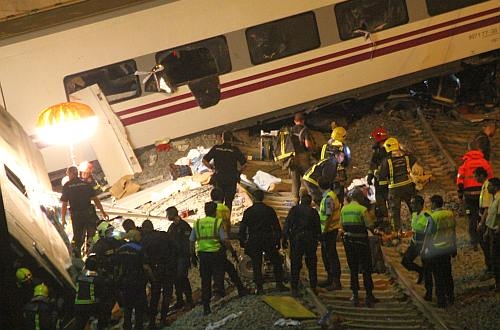The 266-page document points to the human factor as the sole cause of the derailment, as "driving staff failed to follow the regulations contained in the train timetable and the route plan," two printed documents stating maximum permitted speeds for each section between distance markers carried by every driver while on duty.
The driver's lack of attention, caused by a telephone call answered seconds before the derailment, has been defined by the technical investigation as the only contributing cause of the accident.
Despite failing to identify any other direct or contributing causes besides human factors, CIAF, the body responsible for the investigation of railway accidents in Spain, has issued a total of 9 recommendations affecting the entire public rail sector.
Two of these recommendations have been handed down to Adif, inviting the country's rail infrastructure manager to install conventional fixed signals indicating the maximum permitted speed, and balises to control speeds using Asfa, the national ATP system, at locations similar to the sharp curve where the accident occurred, and which were both absent.
Renfe receives two recommendations, one asking the operator to evaluate the possibility of installing video recorders in cabs (a proposal already made by the Spanish government, and the other calling for better coordination of its internal communications procedures.
This latter recommendation is connected with an alert raised by a train driver two weeks before the official opening of the Santiago – Ourense high-speed line in December 2011 The driver expressed concerns were about the lack of conventional speed markers before the curve where the accident occurred.
"There is only a speed reduction signal at km 84.230 (200m before the derailment point) but it is useless because if (when passing the fixed signal) the train has not already decelerated nothing could be done," he said in his report. According to Adif, this communication failed to reach the bodies responsible for infrastructure safety and thus no actions were taken.
The remaining five recommendations are directed to the Transport Ministry to ensure that the orders given to Adif and Renfe are enforced, and that reinforced risk assessment processes are carried out before a new high-speed line is opened.
The report does not mention the lack of working onboard ETCS equipment as a contributory cause. Had it not been disconnected in June 2012 due to compatibility problems, the onboard ECTS equipment would have triggered an alert when the train was passing the final ETCS balise on the high-speed line, located 4km from the crash site, obliging the driver to acknowledge the train position, and triggering an emergency brake application if he had failed to do so.
The Spanish rail investigation body depends entirely on the Transport Ministry. Its president and its five board members are directly appointed and removed by the minister. It has no permanent inspectors and is assisted in its investigations by Ineco (a company entirely owned by the Transport Ministry). When an accident occurs an ad hoc investigation team is formed, and it is always composed by a member of the Ciaf secretariat and two safety executives from both Adif and Renfe.
The Ciaf report is independent of the judiciary investigation still underway and which has summoned not only the train driver, but also a dozen Adif board members which were in office when the Ourense – Santiago line opened (including the former president Mr Antonio Gonzalez) to give evidence.
The final report can be viewed in full (Spanish text PDF) on the ministry's website.

